The Linyanti is a safari addict’s bush nirvana. One of the most remote and exclusive pockets of Botswana, this pristine wilderness is what great game viewing and wildlife documentaries are made of.
Only private concessions are on offer here, where the rules are flexible and the crowds can’t go. The Linyanti is not just for ticking off the big game; it also has a knack for delivering lesser-spotted bucket list items, whether it’s a rare bush pig or that long-searched-for wild dog.
Very few camps operate in the Linyanti. Each offers different habitats and landscapes with one common theme: a strong track record for game viewing during Botswana’s drier winter months. Together with the Chobe Riverfront, the Linyanti homes the highest density of African elephants in the world. Many camps also offer seasonally dependent water-based experiences, be it on a spillway, river, lagoon or channel to break up the game drive routine.
Just one of the Linyanti’s concessions alone is twenty times the size of Manhattan, yet only forty people can stay during any night of the year. If Botswana puts a heavy emphasis on preserving the wild and taking only a handful of people into the bush, then the Linyanti is where this concept is taken to the extreme.
Here, you can follow the big game off-road, whether in a white-knuckled pursuit of a lioness chasing buffaloes, or during a quiet crawl off-track to see wild dog puppies emerging from their den for the first time.
Possibilities exist for exploring the bush on foot for adrenaline-pumping game approaches, and many camps offer game viewing hides for a more relaxed approach to wildlife sightings, or even overnight sleep outs.


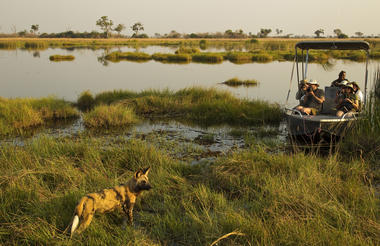
The Okavango Delta is where the wild things are: an immense, waterlogged oasis alive with elephants and birdlife, adrift in the middle of Kalahari sands. The real magic of the Delta lies in its water, trickling through from far away highlands, and spreading across the channels and floodplains.
During winter in the Kalahari, when the sun has baked the earth bare and turned the desert its driest, water fills the Okavango; transforming the floodplains into a Noah’s Ark of African wildlife.
As the water brings life to the delta, its local residents shape and recreate it. Termites slowly build mounds into islands, germinated with palm trees by passing elephants. Waterways open and close on the whim of wide-bottomed hippos, carving out channels where they crash through reeds, and leaving room behind them for exploration by mokoro.
The Okavango has many faces, which change throughout the year, prompted by that most unpredictable diva of all: the weather. Water levels rise and drop, expanding and shrinking islands, while animals move where the life is easiest and the grass greenest. In a few days, a sandy road driven by vehicle can become a waterway of unknowable depth, prompting a safari by boat instead.
Where and when you stay in the Okavango Delta will hugely influence what you do in the bush each day, the animals you’re most likely to see and finally, the safari experience you’ll have.
The delta’s watery heart is best discovered by mokoro through shallow channels and floodplains, as well as crossing the islands on foot. For less water and more of the big game, visit a camp on its drier edges (including Moremi Game Reserve and the Khwai Community Area), jump on a vehicle and seek out the animals hiding in the woodlands.
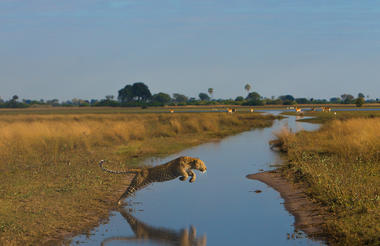
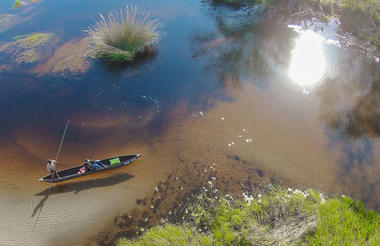
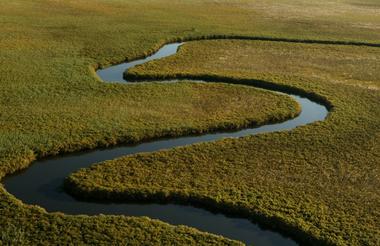
If the middle of nowhere had a name, it would be the Central Kalahari Game Reserve. Out here, you’ll learn the true meaning of remote, wild, vast and open nothingness. This is one of the biggest wildlife reserves on the planet, anchored atop the largest sand basin in the world: the Kalahari Desert.
Here, the skies are huge and tall yellow grasses stretch on forever. Standing under the stars at night, you could easily believe yourself to be alone with the universe, until the distant call of a Kalahari lion tells you otherwise.
Come here during the later green season months (January – April) and the open plains turn a brilliant green against blinding blue skies. Huge herds of white-faced springboks and long-horned gemsbok spill into the open landscape, giving birth to their young while hungry cheetahs and lions follow close by. During the winter (May – October) the landscape fades yellow and brown as antelope herds thin out in search of food.
Sunsets here sink slowly through the sky, growing pink and red the closer they drop to earth. Here, you can watch the sun hit the ground from almost anywhere, with only an acacia tree or two lying between you and the horizon.
The grasslands of the Kalahari are an open stage, changing from hour to hour and, even more dramatically, from one month to the next. A plain lying empty during the morning might be watched over by birds of prey by the afternoon. As the light sets on the day, you might find bat-eared foxes and scavenging jackals trotting across your field of vision instead. Or, if you’re really lucky, you just might catch one of the Kalahari’s big cats strolling past as antelopes freeze into statues waiting for whatever comes next.



Situated along the banks of the Thamalakane River, in the North-West District of Botswana, Maun, a term that derives its name from the San language, meaning "the place of reeds," serves as the administrative town center of Ngamiland. Maun is notoriously known as a "Frontier" town, and is referred to as the 'gateway' to the Okavango Delta and Moremi Game Reserve as most tourists enter these destinations through this buzzing town.
Although classified as one of the fastest growing towns in Botswana, and boasting one of the busiest airports in Southern Africa, Maun still retains much of its old/traditional (village-like) character, which encompasses the old judicial court of chiefs who are still active. Reed and mud hut infrastructures are seen in and around town as well as donkeys/carts and livestock. However, numerous hotels, lodges, bed and breakfasts, shopping malls, post offices, a museum and a big hospital are available too. Maun also serves as the headquarters for the safari industry, tour operators and air charter companies that offer trips into the Okavango Delta and National Parks such as Moremi Game Reserve, Khwai, Savute, Makgadikgadi, Chobe, Nxai Pan to name a few, as well as monumental historical sites like the Tsodilo Hills. Opportunities to visit nearby cultural villages can also be arranged from this central point.
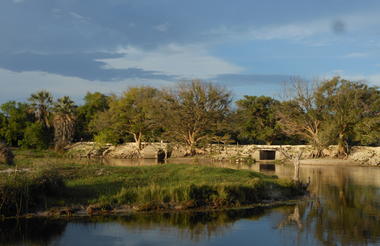


 (1) (002)1.png?fmt=png)


 (1) (002)1.png?fmt=png)
